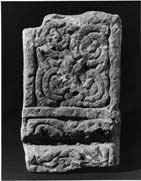Select a site alphabetically from the choices shown in the box below. Alternatively, browse sculptural examples using the Forward/Back buttons.
Chapters for this volume, along with copies of original in-text images, are available here.
Object type: Incomplete cross-shaft [1]
Measurements: H. 40 cm (15.75 in); W. (max.) 26 cm (10.25 in); D. 16.5 cm (6.5 in)
Stone type: Coarse-grained, massive yellow sandstone
Plate numbers in printed volume: Pl. 24.122-125
Corpus volume reference: Vol 1 p. 56-57
(There may be more views or larger images available for this item. Click on the thumbnail image to view.)
A (broad): Two panels of interlace are surrounded and divided by flat-band mouldings. (i) Two registers of spiralled pattern A. (ii) Almost destroyed by reuse.
B (narrow): A muddled design of a six-cord plait, surrounded by a flat-band moulding.
C (broad): Two panels are surrounded and divided by a flat-band moulding. (i) The remains of a pendent ring-knot. (ii) A design of S-shaped incised spirals.
D (narrow): A panel of muddled four-cord plait, surrounded by a flat-band moulding.
This stone is clearly linked with the Lindisfarne tradition in its layout with its small plait panels and plain reserved panels. The rounded loops on face A are reminiscent of Lindisfarne 2-3. The strange incised spirals are also found at Lindisfarne on a shaft (no. 7), which is possibly not much earlier than this one. It is possible that in both centres they reflect the influence of Anglo-Scandinavian art. However, the grooved technique, the flat uneven mouldings and muddled interlace patterns on the narrow faces here, all betray a falling away in competence.



